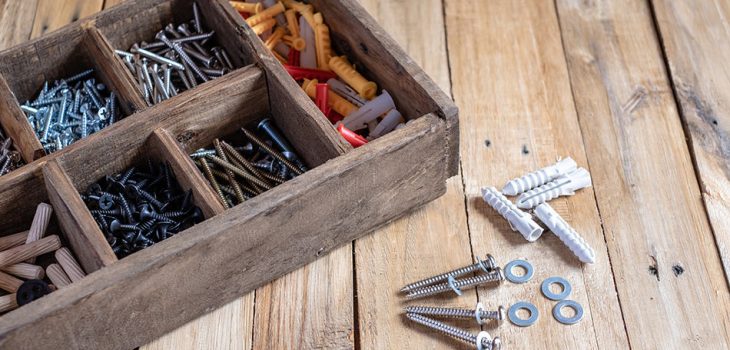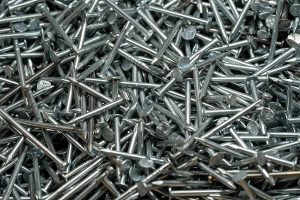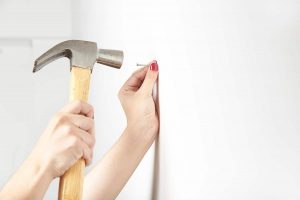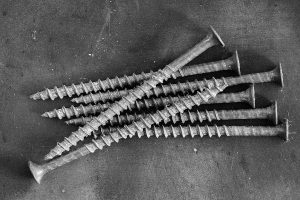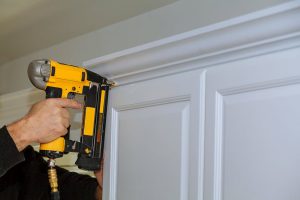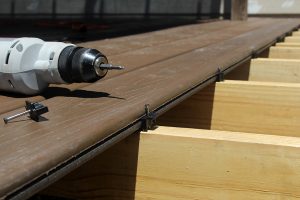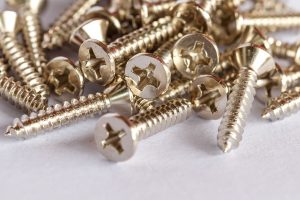(including round, oval, and square heads)
1. Decking screws
Decking screws are made of stainless steel or carbon steel and specially designed to attach wooden or composite boards to metal or wood. These screws come in various widths and lengths and are the perfect solution for fastening decking boards to frames.
Advantages of decking screws:
Used for fastening wood or composite deck boards to frames, thus making them ideal for the shipbuilding industry
Widely used in exterior fence-building applications
Can fasten wooden chairs and simple decking structures
No pre-drilled holes are required
2. Pan-head screws
Pan-head screws have flat heads with rounded sides and are commonly used for metal applications. These machine screws are similar to rounded oval head screws, with the difference being that the oval head types are also rounded on top, whereas the pan-head screws are flat heads.
Pan-head screws are also available in slotted heads with a single cut that makes them compatible with the screw drive of any screwdriver.
3. Hex cap screws
Hex cap screws are large-sized bolts with a hexagonal head – hence their name! They are used to attach wood or metal to wood .
Hex screws consist of tiny steel threads that make them ideal for interior home improvement projects or stainless steel exterior tasks. These screws also feature a flat washer under the screw head and provide precise applications.
4. Carriage bolts
Carriage bolts
Carriage bolts are specifically used in woodworking projects to fasten metal to wood. These bolts have a domed head that prevents loosening.
The large head shape of carriage bolts also prevents them from getting pulled through a wooden construction.
Aside from being intended for use in woodworking projects, carriage bolts are just as suitable for metal applications thanks to their machine screw thread.
Having said that, carriage bolts are not compatible with drill adaptors so installing them into the metal can be rather difficult if not impossible.
5. Lag bolts
Lag Bolts
Lag screws typically consist of a hexagonal head and are designed for high-impact applications. The most common places you can find these screws include decks and wood-retaining sidewalls.
Lag bolts are extremely strong, durable, and long-lasting . They are mostly made of high-carbon steel for the core with an outer galvanized zinc.
The galvanized zinc material protects them from rust and corrosion. What’s more, moisture and air can’t penetrate into lag screws, thus making them rust-resistant .
6. Hammer drive screws
Hammer drive screws are in the same category as self-tapping screws. They consist of unslotted round heads used for attaching name plates or signs as well as for sealing drain holes. Hammer drive screws are also highly useful for rust-proofing tubular structures.
These screws function similarly to nails as they are driven into holes using a hammer or mallet for a quick assembly. It’s worth bearing in mind that the screw must be of sturdier material than the mating part.
You’ll also require a small pre-drilled hole for the task to be completed successfully.
The unique design of hammer drive screws makes them highly durable and strong . And aside from being suitable for attaching name plates, they are also ideal for wall signs and other such applications.
7. Square head bolts
Square head bolts are very much similar to hexagonal-shaped cap screws, but instead of a 6-sided hex head, they have a 4-sided square head . This square head enables a better wrench grip for fastening.
Square head bolts are also referred to as screws and are designed to be driven using a grip wrench. These types of bolts are mostly used for aesthetic purposes, such as adding character to a new structure or to match the existing bolts in older buildings.
8. Socket-head cap screws
Socket-head cap bolts are used for applications with limited or tight space . The inner wrenching and cylindrical features of these screws make them suitable for applications where external wrench fasteners can’t be used in. Socket-head cap screws are most commonly used in the automotive industry, machine tools, mining machinery, and engineering applications.
Benefits of socket-head cap screws:
Fewer screws are required for an application, hence fewer holes need to be drilled
Since fewer screws are used, there will be a weight reduction on the component parts
Socket-head screws require less space than hexagonal head screws
9. Oval head screws
Oval head screws are available in undercut or trim heads with shorter screw lengths to allow longer thread grip. This is the case with the oval undercut head screws that come with a more shallow countersink.
The oval countersunk screw heads include an aesthetically pleasing rounded finish top and are mostly used for covering switches. They also make an excellent choice for making the finished product look more attractive. These stainless steel screws are so strong and durable that they eliminate the need for maintenance.
Non-countersunk heads (including flat, raised, or slotted heads)
10. Wood screws
Wood Screws
Wood screws consist of a threaded shaft and are used to connect wood to wood.
These types of screws have different thread times and are available in a range of different heads. The most common wood screw heads, however, are flat and round heads .
Advantages of wood screws:
The round-head varieties are ideal for attaching thin materials to wood
The flat-head screws are highly useful for securing hinges
Regular wood screws are often made from stainless steel or brass to make them more durable
11. Sheet metal screws
Sheet Metal Screws
Sheet metal screws can fasten or connect two pieces of sheet metal together to tubing or other metal types.
There are different types of sheet metal screw heads available including flat, hex, and round .
These slotted screws are made from pure steel with a weather-proof coating of stainless steel or aluminum. They are most commonly used in the welding industry .
12. Thread-rolling screws
Instead of cutting threads into the material, the thread-rolling screws create threads by exerting pressure against the material’s walls.
These screws are mainly used for softer materials , such as wood, plastic, or nylon. Their double lead thread style minimizes torque and enhances pullout power.
This prevents the material from cracking or being damaged. There are some thread-rolling screws that also feature widely-spaced threads that make them easier to insert into pre-drilled holes.
13. Socket-head screws
Socket-head Screws
Socket-head screws are perfect for when you need a fastener to sit below your material’s surface. These types of screws are highly strong and reliable wherever a joint is required.
They are also exceptionally resistant to corrosion . But aside from their sturdiness, they ensure an attractive and quality finish.
Main features and benefits of socket countersunk screws:
Available in different thread sizes
Highly resistant against corrosion
Made of stainless steel
Head height is same as shank diameter
14. Set screws
Set Screws
Set screws are used to fasten an object to or against another object.
For example, a gear or pulley can be secured to a shaft using a set screw. These screws are fully threaded without a head sticking out, and there are many different shapes and sizes available.
The most common variations include:
Flat set screws : these screws adjust to the surface of the application without damaging it by aligning against the ground
Knurled cup screws : they feature a locking action to stop the screw from loosening in high-vibration applications
Cup point screws : these are the most common types of set screws that permanently hold components on hard or soft surfaces
15. Weld screws
Weld screws are welded to an aluminum or metal surface to create a shaft for the components that are to be fitted or fastened. This can be done using a washer or nut. The tabs of weld screws extend from the head in order to allow welding without using a hole. The welding stud is then fastened to a metal piece. This stud is located on the metal’s base.
These types of screws are most frequently used in the automotive, industrial, marine, construction, cookware, and aerospace industries.
16. Raised or slotted cheese screws
Slotted cheese head screws are made from stainless steel and are designed with a round, raised head. The cheese head’s height is almost equal to half the head’s diameter.
These screws are highly popular in industrial, electrical, telecommunication, and automotive lighting applications due to the fact that they are extremely rust and corrosion-resistant and can be used in underwater projects.
17. Fillister head screws
Fillister head screws are slotted head machine fasteners with a large over-sized head that can be used for attaching metal or wood to metal .
Also referred to as cheese head screws, the fillister head fasteners are similar to pan head machine screws but with a bigger side height. The head of these screws is mainly preferred for counterbored holes.
18. Drywall screws
Drywall screws are standard fasteners for securing partial or full sheets of drywall to wall or ceiling joists. There are two types of drywall screws available. These are:
Coarse : this type of drywall screw is mostly used for wood studs. The widely arranged threads are effective in gripping the wood. Drywall screw also features an extra sharp tip and a phosphate finish.
Fine : this type of drywall screw is self-threading, thus making it perfect for metal studs. The fine drywall screws have double threads for easier and more practical self-starting.
Combination heads
19. Concrete or masonry screws
Concrete screws come in all kinds of head designs, from flat and pan to slotted hex . The pan and flat head screw styles can be flush to the surface of the material to make it look nicer, while a hex-head slotted screw is easier to drive in. Because of the high-low threading design of these screws, they provide durable and solid results in attaching to concrete or stone.
Main features of masonry screws:
High-pressure strength
Offer different head type designs for concrete or stone applications and surface treatment
Most of them have corrosion coating for durability
20. Machine screws
Machine Screws
Machine screws are used to hold parts of machines in all kinds of industries, such as electronics, engineering, and manufacturing equipment.
These screws are specifically designed to fasten to a tapped hole on a surface with the help of a nut. Their blunt ends are used to attach metal parts together. Machine screws can be found in almost every material including nylon, brass, stainless steel, and carbon steel.
21. Modified truss screws
Modified truss screws are the self-tapping varieties that are also known as round washer heads or wafer heads. They are used in numerous industries, from HVAC to sheet metal and woodworking .
These screws can be used to attach the air conditioner’s ductwork parts or for insulation installation on wood and metal surfaces. You can also use them for simple metal or aluminum framing tasks.
Why use truss screws:
Larger truss heads provide a bigger bearing surface area for fastening metal frames
The low-profile heads perfectly meet the installation requirement for fastening metal to steel or wood
Spin-outs are minimized thanks to the Phillips head’s deep drive
22. Washer-faced screws
Washer-faced screws come in several types of washers that act as springs to reduce the distance between the head of a nut and bolt. In addition to their spring feature, some washer-faced screws have teeth that penetrate into the surface and lock the screwhead to the workpiece. These screws are also known as shaker-proof lock washers with twisted-out teeth.
23. Thread-cutting machine screws
Thread-cutting machine screws consist of sharp edges so it’s important for the depth of the hole to be a little longer than the screw. This will avoid the material from getting trapped inside the device. The role of thread-cutting screws is to minimize the creation of internal device stresses, thus making them ideal for extremely stiff materials.
This is in contrast to a thread-forming screw, whose edge does not have any cutting, which makes it difficult in materials with low compressive strength force. But this forms a tight bit between the thread-forming screw and the material.
24. Self-drilling SMS
Self-driving SMS
Self-drilling screws come in different lengths of drill tips. The highest number is equal to a longer drill tip. You also have the option of choosing different point sizes based on their diameter.
Bear in mind that the material’s thickness will affect the length requirements of the point. Self-drilling screws also have a variety of uses and types and are mainly used for fastening or joining sheet metal or steel to other metals.
25. Self-tapping screws
Self-tapping fasteners tap their own thread, hence the name. To use them, you need to drill a hole slightly smaller than the screw’s diameter.
Once you’ve drilled a pilot hole into a soft material like wood, you can then drive the self-tapping screw in. The threads of the screw will dig into the wood and keep it secure.
Self-tapping screws can, in fact, be used in all kinds of materials like metal and brick, not just wood. For harder surfaces, it may be best to choose the self-tapping screws that have pointed tips on their thread in order to cut into the material. However, not all self-tapping screws have pointy tips; some will be flat or blunt so make sure you choose the right one for your specific application.
26. Framing screws
Framing screws are multi-use fasteners for sheet metal, wood, laminate, composite decking, and cement fiber board applications. These screws are designed to countersink into many different materials, from hardwood flooring to brittle composite. This can be achieved by the cutting teeth of the screw’s underhead as well as the six cutting pockets.
Framing screws work very similarly to circular saw blades as they prevent the sawdust from getting to the edge of the screw hole. The hole can then be sealed off without damaging the surface of the material.
Tamper-resistant heads
27. Tamper-resistant screws
Tamper-proof screws are suitable for use in buildings or areas that are accessible by the public to prevent or deter vandalism. This security screw type can be distinguished by its unconventional drive, which makes tampering or disassembly more difficult, if not impossible.
These tamper-proof screws are mainly used for securing materials, such as car licence plates, gutters, and grill bars in prisons.
Screw-type bolts
28. Sex bolts
Sex Bolts
Sex bolts are in the same category as mating screws. They are also known as interscrews, barrel nuts, partition screws, panel fasteners, binding posts, Chicago screws, and architectural sex bolts.
A sex bolt is a type of nut or fastener with a barrel-shaped flange and pointed boss that’s internally threaded.
This bolt with its accompanying machine screw sits on either side of a material or surface that requires securing. These types of nuts are chosen for their low-profile and built-in slot features, which aid in tightening the screw into the surface.
29. Eye bolts
Eye Bolts
Eye bolts are perhaps the most commonly used screws by both homeowners and material handling specialists. In fact, you are bound to have come across these bolts in your local hardware store.
An eye bolt consists of a threaded shank and a ring at one end . These bolts are designed to lift objects by passing a rope or wire through their eye.
Different uses for eye bolts:
In industrial settings , the larger-sized eye bolts are used for lifting and tensioning.
In homes , they are used for hanging decorations or plants on walls
In welding industries , stainless steel eye bolts are ideal for harsh weather conditions as they can be used for heavy-duty outdoor welding applications
30. J-bolts
J-bolts
J-bolts are J-shaped screws that are threaded on their flat side. These bolts are often used in construction applications like connecting walls to stone or concrete foundations.
The curved end of J-bolts are for extra support and can be placed in concrete for use as anchor fasteners. The long end of these screws come in different lengths and they can be threaded using a hook, hence the end result will look like a J.
31. U-bolts
U-bolts
U-bolts are industrial fasteners that are U-shaped with two threaded legs or arms to provide a bent base. These threaded legs or arms are designed to be used with screws and washers, but they can also be used with a crosspiece for a more secure result.
A U-bolt can be inserted in pre-drilled or punched holes and is most commonly used in plumbing, industrial, and construction projects.
32. Shoulder bolts
Shoulder Bolts
Shoulder bolts are in the same category as machine screws. They comprise the head, shoulder, and threading, with the head part having the largest diameter.
These bolts are especially known for their unique features and versatility . They are used in a variety of industries, from automotive to wooden furniture making .
They are also useful for pulleys and linkages. Shoulder bolts are often found in exterior wooden structures.
33. Elevator bolts
Elevator bolts
Elevator bolts enjoy a wide variety of application usage. For example, they can secure any type of flooring, and level wooden furniture legs , and you can even find these bolts on skateboards and snowmobiles.
The threads are designed as standard right-hand and you can choose from long to short lengths that are fully threaded. The length measuring starts from the top of the head all the way to the end of the threaded fastener.
The head of an elevator bolt can be countersunk flat, shallow conical, square neck under the head, or a unified thread to name a few.
34. Hanger bolts
Hanger bolts
Hanger bolts are headless screws used mainly with wood applications to provide an additional external thread or to create an internal fastening joint.
One side of the hanger bolt thread, together with a self-tapping lag screw, grips into the wood, while the other side of the bolt has machine screw threads for a nut. Because of such features, hanger bolts are extremely popular in storm shutter applications, and they are commonly used in furniture making, framing, and flooring joints .
